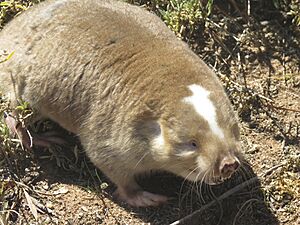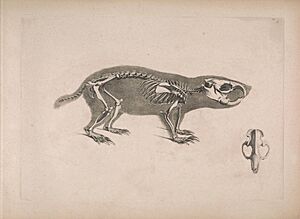Cape dune mole-rat facts for kids
Quick facts for kids Cape dune mole-rat |
|
|---|---|
 |
|
 |
|
| Conservation status | |
| Scientific classification | |
| Genus: |
Bathyergus
|
| Species: |
suillus
|
The Cape dune mole-rat (Bathyergus suillus) is a special type of rodent that lives underground all by itself. It belongs to the Bathyergidae family, which includes other mole-rats. You can only find this animal in South Africa, and it gets its name from the famous Cape of Good Hope.
Contents
What Does the Cape Dune Mole-Rat Look Like?
The Cape dune mole-rat is the biggest of all the blesmols. It measures about 27 to 35 centimetres (11 to 14 in) from its head to its body, with a short tail that is only 3 to 4 centimetres (1.2 to 1.6 in) long. Male mole-rats are usually heavier than females. Males can weigh from 570 to 1,350 grams (20 to 48 oz), while females typically weigh between 590 to 970 grams (21 to 34 oz).
Both male and female mole-rats have strong, large bodies. They have blunt snouts, bodies shaped like cylinders, and short legs. Their front paws are perfect for digging, with strong, curved claws. To help them move easily through tight tunnels, their bodies have very few bumps or parts sticking out. They even have special skin flaps behind their front teeth that can close to stop soil from getting into their mouths while they dig! Their eyes are small, but they can still see.
Unlike its relative, the naked mole-rat, the Cape dune mole-rat has thick, soft fur all over its body. It is usually cinnamon-brown with grayish fur underneath. It doesn't have many markings. Like other blesmols, the Cape dune mole-rat has a body temperature of about 35 °C (95 °F), which is a bit lower than many other animals. This means it doesn't do well in cold weather above ground.
Where Do Cape Dune Mole-Rats Live?
The Cape dune mole-rat lives only in South Africa. You can find them along the southern and western coasts, roughly between the towns of Vanrhynsdorp and Port Elizabeth. Their favorite places to live are sandy beaches and river banks. These areas are usually covered with veldt grasslands, sedges (grass-like plants), and other small plants.
What Do Cape Dune Mole-Rats Eat and How Do They Behave?
Cape dune mole-rats are strict herbivores, meaning they only eat plants. They mostly eat grass and sedges, which they pull down into their burrows by the roots. They also enjoy eating bulbs and tubers from local plants like Albuca and cape tulips. Since they almost never come above ground, they don't have a clear day or night schedule. They can be active at any time, but they seem to be busiest in the afternoon.
Most other blesmols are social animals, living in groups. But the Cape dune mole-rat is different! It is not social at all. Each mole-rat lives alone in its own separate burrow system. Many mole-rats dig using their big front teeth, like chisels. However, the Cape dune mole-rat lives in loose, sandy soil, so using teeth isn't as effective. Instead, they dig mainly with their strong claws. They kick the sand behind them and then push it up to the surface, creating a molehill.
Their burrows are completely sealed, with no openings to the surface. These tunnel systems can stretch for 50 and 420 metres (160 and 1,380 ft) and cover an area of about 0.27 hectares (0.67 acres). It's amazing to think that one mole-rat can dig up to 500 kilograms (1,100 lb) of soil in just one month if the conditions are right!
These burrows have many tunnels that the mole-rat uses to search for food. They also have a few deeper rooms for nesting, storing food, and as bathrooms. Most tunnels are about 35 and 65 centimetres (14 and 26 in) underground. But there are often some dead-end tunnels that go as deep as 2 metres (6 ft 7 in). The mole-rat uses these deep tunnels to escape from predators like mole snakes. When it hides, it blocks the tunnel behind itself. The burrows protect the mole-rats from extreme weather. Inside, the air is always humid and has low oxygen.
The breeding season for Cape dune mole-rats is from April to November, when there is plenty of rain. When a male and female are ready to mate, they signal to each other by drumming on the floor of their burrows with their back legs.
A mother mole-rat is pregnant for about two months. She usually gives birth to a litter of up to six young, but three is common. When they are born, the babies are blind and weigh about 27 to 52 grams (0.95 to 1.83 oz). They open their eyes at seven days old and start eating solid food at twelve days. They are fully weaned (stop drinking milk) by the end of their first month. The young mole-rats often play-fight with each other. After about two months, they leave their mother to dig their own burrow systems. By this time, they are already nearly half the size of an adult. Cape dune mole-rats can live for over six years.
Naming and Family Tree
The Cape dune mole-rat was first described by a German scientist named Johann Christian Daniel von Schreber in 1782. He gave it the scientific name Mus suillus. Over time, other scientists gave it different names, but in 1926, another scientist named Austin Roberts realized that Von Schreber's name was the first and therefore the correct one. So, the official scientific name became Bathyergus suillus.
The genus name Bathyergus comes from Greek words that mean "deep digger." The species name suillus comes from a Latin word meaning "pig," which refers to its pig-like nose.
The Cape dune mole-rat is one of only two living species in the Bathyergus group. The other is the Namaqua dune mole-rat. Scientists believe that both of these living species might have come from an older, extinct species called Bathyergus hendeyi. This ancient mole-rat lived about four million years ago in the same area of South Africa.
Images for kids





